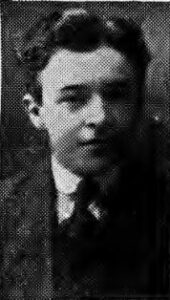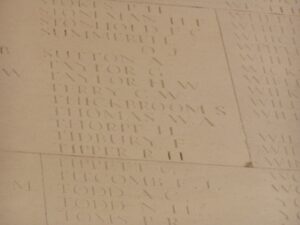Llangeler is a hamlet and a parish which is located roughly mid-way between Newcastle Emlyn and Llandyssul, on the northern edge of Carmarthenshire County. The war memorial is located inside St Celert’s Church, and photographs of it have kindly been supplied by Raymond Jones. Surprisingly, out of less than forty casualties suffered by the Welsh Horse Yeomanry, just nineteen of which died overseas, prior to the regiment being merged with the Montgomery Yeomanry to form the 25th Battalion, Royal Welsh Fusiliers, three of these were from the small village of Llangeler.
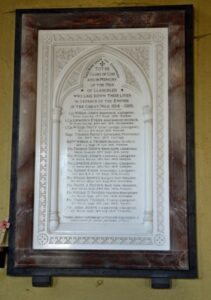
The Great War, 1914-1918
David John Davies, Private, 51866, West Yorkshire Regiment. David was the son of John and Sarah Davies, of Graigwen, Velindre. He resided at Belle Vue, Velindre with his wife Margaret Jane Davies, and their daughter Hannah prior to the war, and enlisted at Cardiff in February 1917. David originally served with the Labour Corps before transferring to the 2/8th Battalion, West Yorkshire Regiment on 28 September 1917, which was attached to 185 Brigade, 62nd (2nd West Riding) Division. The Division had been in France since January 1917, and took part in the Battle of Arras. It fought at Cambrai later that year, before settling down for the winter in the Arras sector. On 21 March 1918 the German Spring offensive hit the area, and the Division was one of several to suffer terrible casualties over the coming days. David was killed on 29 March 1918, aged 33. He has no known grave, and is commemorated on the Arras Memorial, France.
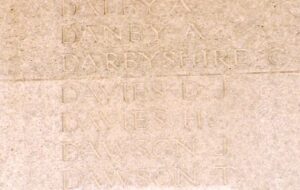
Thomas Davies, Private, 1446, Welsh Guards. Thomas was the son of John and Mary Davies, of Rhydgalfe, Llandyssul. He enlisted at Aberystwyth into the 1st Battalion, Welsh Guards, which had been formed by Royal Warrant of 26 February 1915. They landed at Havre on 8 August 1915, where they were attached to 3 Guards Brigade, Guards Division, and saw their first action at the Battle of Loos the following month. Thomas was killed in action at Loos on 27 September 1915. He was 23 years old, and has no known grave, and so is remembered on the Loos Memorial, France.
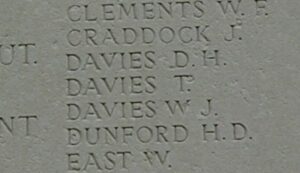
Thomas Davies, Sapper, 223291, Royal Engineers. Thomas was the son of Elizabeth Evans, of Penbane, Velindre, and the husband of Hannah Davies, of Glyncaled, Pentrecourt, Llandyssul. Thomas enlisted at Llandyssul into the Royal Engineers, and was posted to their 411th Field Company. Thomas was stationed at the Curragh in Ireland in 1917, where he sadly died of sickness on 20 May 1917. He was 27 years old, and was brought home for burial at Llangeler (St. Celer) Churchyard.
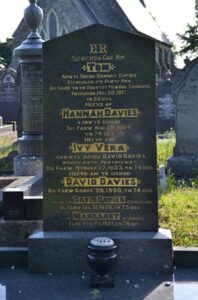
Llewellyn Evans, Lance Corporal, 136, Welsh Horse. Llewellyn was born at Cenarth in 1880, the son of David and Anne Evans. He married in 1904, and resided with his wife Mary Evans at 8, Railway Terrace, Henllan. Llewellyn was a veteran, who had served during the Boer War, and he enlisted at Henllan into the 1/1st Battalion, Welsh Horse Yeomanry, which was originally raised as a Welsh Cavalry unit. Around February 1915 the Welsh Horse joined the 1/1st Eastern Mounted Brigade, 1st Mounted Division in Woodbridge area, but in September 1915 dismounted and sailed from Liverpool in the SS Olympic on 25 September, landed at Anzac, where it became attached to the 54th (East Anglia) Division. The Welsh Horse were used as tunnellers on Gallipoli, and it was while working on a tunnel that Llewellyn was killed, when the Turks blew a mine on 20 November 1915. Llewellyn was buried at 7th Field Ambulance Cemetery, Gallipoli, alongside two of his comrades who died alongside him, Llewellyn Jones of Llangeler, and W.C. Lewis of Carmarthen.
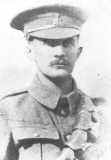
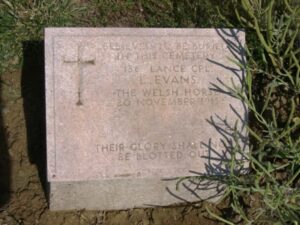
Samuel Evans, Private, 19029, Royal Welsh Fusiliers. Samuel was probably the son of Samuel and Mary Evans, of Blaenllain, Llangeler. He was living in Pontypridd by 1901, and by 1911 was living with his wife, Elizabeth Evans, at 2, Rhondda Road, Pontypridd. He enlisted at Pontypridd into the 17th Battalion, Royal Welsh Fusiliers, which was attached to 115 Brigade, 38th (Welsh) Division. Samuel landed in France with the battalion during December 1915, and would have taken part in the attack on Mametz Wood in July 1916. The division moved to Ypres in the summer of 1916, and on 31 July 1917 launched its famous assault on Pilckem Ridge. After wintering in the Armentieres sector, at the end of March 1918 the division moved back south to the Somme, and for several months held the line north of Albert, around Aveluy Wood. It launched its offensive across the River Ancre on 23 August 1918, which began its drive towards the Hindenburg Line. Samuel was killed during heavy fighting near Ginchy, on 10 September 1918, aged 38. He has no known grave, and is commemorated on the Vis-en-Artois Memorial, France. The memorial shows that he died on 1 September, but that is an error.
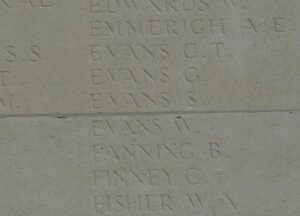
William Howells, Private, 2536, Welsh Regiment. William was the son of Samuel Howells, of Bargoed View, Velindre. He enlisted at Carmarthen into the 1/4th Battalion, Welsh Regiment, which was the local Territorial unit. The battalion was attached to 159 Brigade, 53rd (Welsh) Division, and sailed from Devonport in July 1915 arriving at Mudros on 5 August 1915. From here they moved to Gallipoli, landing on 9 August. Here the Division was immediately thrown into action, and spent the next few days in isolated pockets, fighting against a Turkish counter-attack during the Battle of Sari Bair. William was killed here on 10 August 1915. He was 21 years old, and is commemorated on the Helles Memorial, Gallipoli.
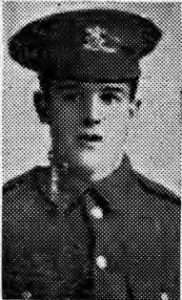
Hugh Jones, Private, 109040, Notts & Derby (Sherwood Foresters). Hugh was born at Llangeler, the son of Owen and Isabella Jones. The family later moved to 25, Camden Street, Derby Road, Bootle, Liverpool. He served with the 1st Battalion, Sherwood Foresters, which was attached to 24 Brigade, 8th Division. The Division had been on the Western Front since November 1914, and had fought in almost all of the major battles of the war. They were caught up in the German spring offensive of 21 March 1918, and took part in heavy fighting during the following days. Hugh was probably taken prisoner during this time, and died as a POW on 3 October 1918. He was 19 years old, and is buried at Berlin South-Western Cemetery, Germany. Hugh is not named on the war memorial.
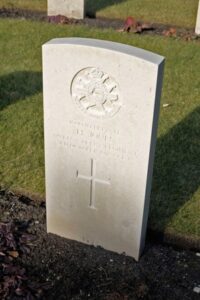
John Jones, Private, 4335, Welsh Regiment. John was the son of Mary Jones, of Cwmcerrig, Llangeler. He enlisted at Ammanford into the 1/4th Battalion (Carmarthen), Welsh Regiment, which was attached to 159 Brigade, 53rd (Welsh) Division. On 19 July 1915 the battalion sailed from Devonport for the Mediterranean, and on 9 August 1915 landed at Suvla Bay, Gallipoli. The 4th Welsh were immediately thrown into battle, and suffered terrible losses over the coming days. John was killed on 11 August 1915 during the attack on Sari Bair. He was 23 years old, and is commemorated on the Helles Memorial, Gallipoli.
Llewellyn Jones, Private, 540, Welsh Horse. Llewellyn was born in 1890, the son of Ruth Jones, of Llainwen, Llangeler. He enlisted at Diss, Norfolk into the 1/1st Battalion, Welsh Horse Yeomanry, which was originally raised as a Welsh Cavalry unit. Around February 1915 the Welsh Horse joined the 1/1st Eastern Mounted Brigade, 1st Mounted Division in Woodbridge area, but in September 1915 dismounted and sailed from Liverpool in the SS Olympic on 25 September, landed at Anzac, where it became attached to the 54th (East Anglia) Division. The Welsh Horse was used as a labour unit, digging trenches and tunnels on Gallipoli. Llewellyn was among six men killed while working on a tunnel, when the Turks blew a mine on 20 November 1915, bringing the roof down. The remains of the 25-year-old were recovered from the mine and buried in the 7th Field Ambulance Cemetery alongside two local men, Llewellyn Evans of Henllan, and William Cooper Lewis, of Carmarthen.
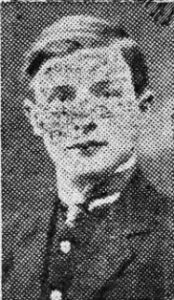
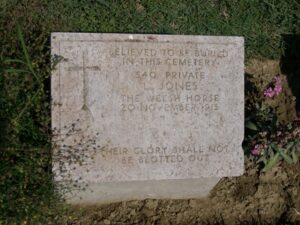
William Jones, Private, 565, Welsh Horse. William married Hannah Evans, of Llainwen, Llangeler, in 1912, adopting her daughter. The couple then had two more children. William enlisted at Diss, Norfolk into the 1/1st Battalion, Welsh Horse Yeomanry, which was originally raised as a Welsh Cavalry unit. Around February 1915 the Welsh Horse joined the 1/1st Eastern Mounted Brigade, 1st Mounted Division in Woodbridge area, but in September 1915 dismounted and sailed from Liverpool in the SS Olympic on 25 September, landed at Anzac, where it became attached to the 54th (East Anglia) Division. The Welsh Horse was used as a labour unit, digging trenches and tunnels on Gallipoli. William took ill on Gallipoli, and was evacuated by Hospital Ship to Egypt, where he died of dysentery on 14 November 1915. He is buried at Cairo War Memorial Cemetery, Egypt.
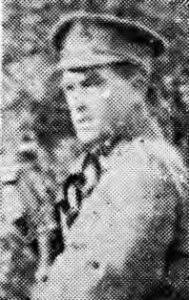
William Jones, MM, Private, 1189, Welsh Guards. William was the son of David and Hannah Jones, of Pantyffyllon, Llangeler. He worked on his parents farm before enlisting into the Glamorgan Constabulary and served as a Policeman, PC 684, at Maesteg prior to the war. He enlisted at Bridgend into the 1st Battalion, Welsh Guards, which had been raised by Royal Warrant on 26 February 1915, and moved to France on 18 August 1915 to join the 3rd Guards Brigade, Guards Division. William was probably one of the original members of the battalion, and would have seen action during the Battle of Loos. In late July 1916 the Division moved to the Somme, where they fought at the Battle of Flers-Courcelette, and it was here that William was mortally wounded, dying the same day, on 10 September 1916, aged 30. William has no known grave, and is commemorated on the Thiepval Memorial, France. He was the holder of the Military Medal.
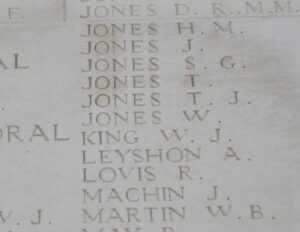
John Thomas Morris, Private, 648321, London Regiment. John was born at Llangeler, near Newcastle Emlyn, the son of John and Elizabeth Morris. The family later moved to 48, Gilbert Place, Llanelli. He originally served with the Welsh Horse Yeomanry, number 187 and served in Gallipoli from 8 October 1915. He transferred after March 1917 into the 6th Battalion, London Regiment, number 324853, before being transferred into the 20th Battalion (Blackheath and Woolwich), London Regiment, number 648321, which was attached to 141 Brigade, 47th (2nd London) Division. The Division was served in France from 1915 and early in 1917 the Division moved north to Belgium, and took part in the Battle of Messines, and then in November 1917 fought at the Battle of Cambrai. The Division remained in the Cambrai sector over the winter, and on 21 March 1918 was caught up in desperate fighting during the German Spring Offensive on the Somme. John was killed in action, his death being presumed on 24 March 1918, aged 26, and is buried at Sailly-Saillisel British Cemetery, France. He is not commemorated at Llangeler.
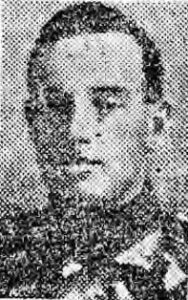
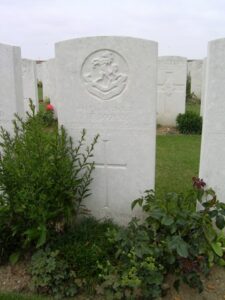
William Perry, Lance Corporal, 6208, Duke of Cornwall’s Light Infantry. William was the son of Henry Perry, of Sampford Brett, Williton, Taunton, and the Husband of Rose Perry, of Winkton, Christchurch, Hants. He resided at Geler Lodge, Llangeler prior to the war, and enlisted at nearby Carmarthen into the 1st Battalion, Duke of Cornwall’s Light Infantry. At the outbreak of war the battalion was at the Curragh. It joined 14 Brigade, 5th Division, and landed in France on 15 August 1914, taking part in the Battle of Mons and the subsequent retreat to the Marne. They took part in the advance to the Aisne, before moving to Flanders, where they fought at the Battle of La Bassée, then at Messines in October, 1914. They fought here through First Ypres, and took part in the capture of Hill 60, and then fought at Second Ypres in April 1915. March 1916 saw the Division moving to positions between St. Laurent-Blangy and Vimy, near Arras, and the Division saw plenty of action during its spell here. On 1 July 1916 the Battle of the Somme opened, and the Division moved south fighting at High Wood, and the Battle of Guillemont. William was killed at Guillemont on 4 September 1916, aged 37. He has no known grave, and is commemorated on the Thiepval Memorial, France.
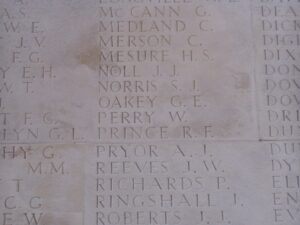
William Dennis Sexton, Private, 202758, Welsh Regiment. William was the son of Denis and Frances Sexton. He married Hannah Jones in 1913, and the couple lived at Pantivor, Pentrecourt, and originally enlisted at Carmarthen into the 4th Battalion, Welsh Regiment. At some time in the summer of 1917, William was posted to France, where he joined the 15th Battalion, Welsh Regiment, which was the Carmarthen Pals Battalion, attached to 114 Brigade, 38th (Welsh) Division. William would have fought with the 15th Welsh during their assault on Pilckem Ridge on 31 July 1917, and in the following Battle of Langemark. After wintering near Fleurbaix, the battalion moved to the Aveluy Wood sector of the Somme in April 1918, and from 21 August 1918 onwards, crossed the River Ancre, beginning their part in the great offensive which drove the Germans back over the old Somme battlefields over the coming weeks. William survived up until almost the last action of the war. He was wounded during the Battle of the Selle, and died on 27 October 1918. William is buried at Inchy Communal Cemetery Extension, which is just a couple of miles from Le Cateau, France.
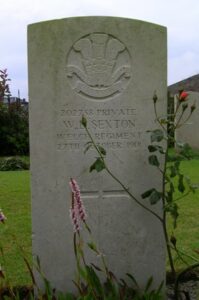
Thomas Thomas, Private, 56931, Welsh Regiment. Thomas was the son of Evan and Ann Thomas, of Towyn, Llangeler. He originally enlisted into the Pembroke Yeomanry at Swansea, before being posted to France to join the 13th Battalion (2nd Rhondda), Welsh Regiment, which was in France attached to 114 Brigade, 38th (Welsh) Division. The Division had suffered heavy casualties during the capture of Mametz Wood in July 1916, before being moved to the Boesinghe Sector, north of Ypres. On 15 January 1917 the 13th Welsh were in the front line near Irish Farm, when a heavy German bombardment inflicted over 40 casualties on them. Thomas was killed during the shelling that day. He was 26 years old, and is buried at Essex Farm Cemetery, Belgium.
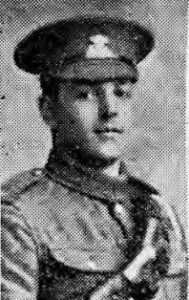
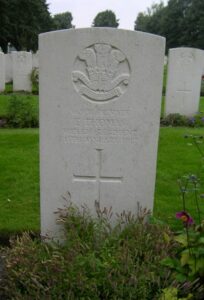
William Alfred Thomas, Rifleman, 471312, London Regiment. William was the son of Thomas and Hannah Thomas, of Bodafon, Drefach. He enlisted at London into the 12th Battalion (The Rangers), London Regiment, attached to the 1st London Division. In December 1914 the Rangers left 1st London Division and landed at Havre 25 December, moving to Lines of Communication. In February 1915 they joined 84 Brigade, 28th Division, and in May moved to G.H.Q. Troops and formed a composite Battalion with 1/5th and 1/13th Battalions until August 1915. In February 1916 the Rangers joined 168 Brigade, 56th (London) Division, which was forming in the Hallencourt area. The Division took part in a disastrous diversionary attack on Gommecourt on 1 July 1916, to draw German attention away from the main attacks a little south, on the Somme. William was posted as missing in action that day, and it took months for official notification of his death to reach his parents at Drefach. He was 19 years old, and is commemorated on the Thiepval Memorial, France.
